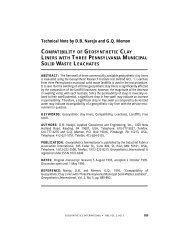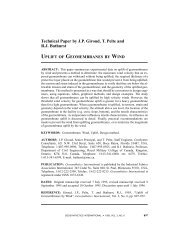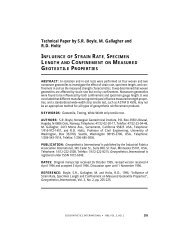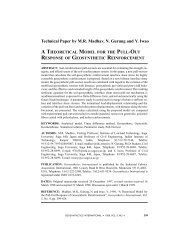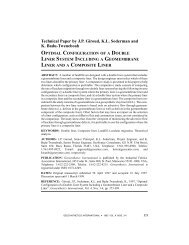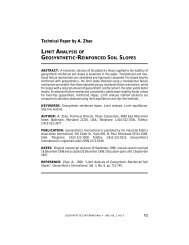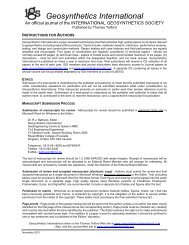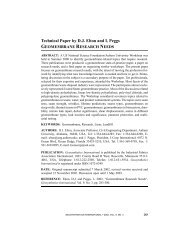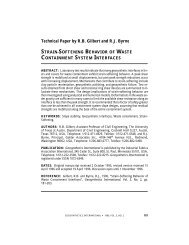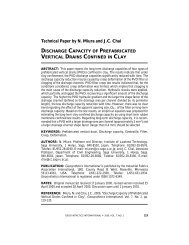Download Paper - IGS - International Geosynthetics Society
Download Paper - IGS - International Geosynthetics Society
Download Paper - IGS - International Geosynthetics Society
You also want an ePaper? Increase the reach of your titles
YUMPU automatically turns print PDFs into web optimized ePapers that Google loves.
PERKINS AND ISMEIK D Geosynthetic-Reinforced Bases in Flexible Pavements: Part II<br />
1 INTRODUCTION<br />
<strong>Geosynthetics</strong> have been proposed and used as reinforcement in the base course layers<br />
of flexible pavements for the past 15 years. Studies have been performed to examine<br />
the feasibility of this application and concentrated on the use of experimental test sections<br />
to demonstrate the performance of geosynthetic-reinforced roadways. The test results<br />
of these experimental studies are analyzed and discussed in a companion paper<br />
written by the authors of the current paper (Perkins and Ismeik 1997). In the majority<br />
of the studies reviewed, it was concluded that an appreciable increase in performance<br />
could be realized by using geosynthetic reinforcement, and that optimal performance<br />
is dependent on many factors.<br />
Improvement has been attributed mainly to the prevention of lateral spreading of the<br />
aggregate base. An improvement is defined as an increase in pavement service life and/<br />
or a reduction in base course thickness. For properly designed sections, improvement<br />
is typically seen for all rut depths and not only for rut depths that render the pavement<br />
inoperable. Suitable frictional and interlocking interaction between the geosynthetic<br />
and the surrounding base course soil are required to prevent spreading of base course<br />
soil. For this reason, geogrids have typically offered greater improvement in performance<br />
as compared to geotextiles. The torsional rigidity of geogrids has an impact on<br />
performance, with torsionally stiff products generally offering better performance.<br />
The importance of separation and filtration was illustrated in several of the studies<br />
reviewed by Perkins and Ismeik (1997); if the section was not properly designed for separation<br />
and filtration, the reinforcement benefit of the geogrid could be minimized. The<br />
test results from these studies also revealed that sections, which were designed to fail<br />
under the operation of traffic repetitions characteristic of permanent roads, experienced<br />
greater improvements in performance as compared to sections which failed in a rapid<br />
manner. For properly designed sections, improvement was seen for a variety of subgrade<br />
conditions, pavement section layer thicknesses, and geosynthetic location and<br />
layering configuration. These studies taken as a whole suggest that the optimal design<br />
of reinforced pavements depends on the following factors: geosynthetic type, manufacturing<br />
process, mechanical properties, placement location, and layering; base course<br />
thickness and quality; asphalt concrete (AC) thickness; subgrade type, strength, and<br />
stiffness characteristics; and load magnitude and frequency of application.<br />
Solutions have been proposed for the design of geosynthetic-reinforced pavements<br />
and have been based either on empirical or analytical considerations. No design solutions<br />
which propose a general analytical solution that has been validated by experimental<br />
data have been identified. The importance of the many variables defined above<br />
which impact performance implies that a successful empirical solution will need to be<br />
developed from an extensive series of experiments involving these variables.<br />
Analytical solutions developed within the framework of a finite element method<br />
(FEM) can potentially account for many of the loading- and materials-related features<br />
thought to impact geosynthetic-reinforced pavement performance. Many of these features<br />
are the same as those which must be incorporated into general, pavement response<br />
FEM models. The FEM model description of loading should account for the time-dependent<br />
nature of the load. Constitutive models employed for the pavement system materials<br />
should account for the time-dependent behavior of the AC layer and the cyclic<br />
behavior of the base and subgrade soils under repetitive loads. Similar considerations<br />
606 GEOSYNTHETICS INTERNATIONAL S 1997, VOL. 4, NO. 6
PERKINS AND ISMEIK D Geosynthetic-Reinforced Bases in Flexible Pavements: Part II<br />
are necessary for the geosynthetic materials, while geosynthetic strength and stiffness<br />
anisotropy should also be considered. Interaction at the soil-geosynthetic interface is<br />
also important and should be considered. Studies involving the development of FEM<br />
models for reinforced pavement systems are summarized in Section 3.<br />
2 EXISTING DESIGN TECHNIQUES<br />
Five studies that describe a design approach for reinforced pavements have been<br />
identified. Haas et al. (1988), Montanelli et al. (1997), and Webster (1993) present empirical<br />
design approaches based on experimental findings from their respective studies.<br />
Davies and Bridle (1990) and Sellmeijer (1990) present design approaches based on<br />
analytical considerations and were not necessarily verified by experimental results.<br />
2.1 Penner et al. (1985)<br />
Penner et al. (1985) presented an empirical design approach based on the experimental<br />
work by Haas et al. (1988). The design approach was based on the pavement design<br />
guidelines published by the American Association of State Highway and Transportation<br />
Officials (AASHTO 1981) and was used for comparing results and developing base<br />
course equivalency charts. This design approach is similar in concept to that used by<br />
Al-Qadi et al. (1997) for comparing experimental results, which is described in the<br />
companion paper by Perkins and Ismeik (1997).<br />
The structural number (SN) of each control section was calculated assuming layer<br />
coefficients of 0.4 for the asphalt layer and 0.14 for the granular base layer. The subgrade<br />
soil support value (S) was determined from the subgrade California Bearing Ratio<br />
(CBR) strength and ranged from 4.3 to 5.7. The values for SN and S were then used in<br />
the AASHTO design method to determine the total equivalent 80 kN single-axle load<br />
applications, which ranged from 60,000 to 10,000,000 applications.<br />
A load correction factor was calculated for each section by dividing the number of<br />
80 kN single-axle load applications by the actual number of load applications necessary<br />
to cause failure (failure was defined as a 20 mm rut depth). This load correction factor<br />
was intended to account for differences in loading conditions between the laboratory<br />
experiments and moving wheel loads in the field. For the control sections, the load<br />
correction factors ranged from 3.5 to 10, which were comparable to the values obtained<br />
by Al-Qadi et al. (1997) (5 to 12.5) using the AASHTO method. The use of these correction<br />
factors can be explained as follows: if the laboratory section was subjected to actual<br />
field loads, a 20 mm rut depth would have developed after a number of load applications<br />
that is equal to the number of load applications required in the laboratory experiments<br />
multiplied by the load correction factor.<br />
This load correction factor was then taken to apply to the reinforced sections within<br />
a particular test series. The load correction factor for each reinforced section was then<br />
used to calculate the 80 kN single-wheel load applications by multiplying the actual<br />
number of load applications experienced in the laboratory tests by the corresponding<br />
correction factor. From the AASHTO method, a SN value for that section was determined.<br />
A SN value for the reinforced granular base was then calculated by subtracting the<br />
asphalt layer SN component from the total SN value. A reinforced layer coefficient was<br />
GEOSYNTHETICS INTERNATIONAL S 1997, VOL. 4, NO. 6<br />
607
PERKINS AND ISMEIK D Geosynthetic-Reinforced Bases in Flexible Pavements: Part II<br />
then calculated by dividing the SN value for the reinforced base by its corresponding<br />
thickness. The ratio of the reinforced to unreinforced layer coefficients was calculated<br />
by using the layer coefficient for the unreinforced granular base, i.e. the control section.<br />
For equivalent base layer SN values, the ratio of the reinforced to unreinforced layer<br />
coefficients is equal to the ratio of unreinforced to reinforced base layer thickness. The<br />
ratio of the reinforced to unreinforced layer coefficients was plotted against the reinforced<br />
base thickness. The graph decreased as the reinforced base thickness approached<br />
250 mm when the geogrid was placed at the bottom of the base. Additional improvement<br />
in the layer coefficient ratio was noted for a base thickness of 250 mm when the<br />
geogrid was placed in the middle of the base. Based on these results, Figure 1 was developed<br />
and shows the relationship between the thickness of a reinforced base to an unreinforced<br />
base when Geogrid A is used (the properties of Geogrid A are listed in the<br />
companion paper).<br />
2.2 Montanelli et al. (1997) and Webster (1993)<br />
Montanelli et al. (1997) also used the AASHTO design method to determine a layer<br />
coefficient ratio for the granular base, which is equal to the ratio of the reinforced to unreinforced<br />
layer coefficients. Values of this ratio ranged from 2 to 1.5 and were determined<br />
from experiments using one geogrid and subgrades with different CBR strengths.<br />
The values greater than 1.5 were calculated for subgrade CBR strengths less than 3. The<br />
layer coefficient ratio value was used as a multiplication factor for the depth of the reinforced<br />
base in the equation used to calculate the structural number. This implies that for<br />
an equivalent structural number, the unreinforced base could be reduced by 33 to 50%.<br />
Webster (1993) produced a design chart similar to that of Haas et al. (1988) by directly<br />
comparing and extrapolating test results for sections of equivalent base course thickness.<br />
The original design chart included the 50 mm thick AC layer used in the experiments.<br />
The authors of the current study have modified the original chart by excluding<br />
the 50 mm thick AC layer which resulted in the chart shown in Figure 2.<br />
Reinforced base thickness (mm)<br />
400<br />
Geogrid at midpoint of base layer<br />
300<br />
Geogrid A<br />
200<br />
Geogrid at bottom of base layer<br />
100<br />
0<br />
0 100 200 300 400 500 600<br />
Unreinforced base thickness (mm)<br />
Figure 1. The flexible pavement design chart proposed by Haas et al. (1988) (from<br />
Penner et al. 1985).<br />
608 GEOSYNTHETICS INTERNATIONAL S 1997, VOL. 4, NO. 6
PERKINS AND ISMEIK D Geosynthetic-Reinforced Bases in Flexible Pavements: Part II<br />
Reinforced base thickness (mm)<br />
400<br />
300<br />
200<br />
100<br />
0<br />
0 100 200 300 400 500 600<br />
Unreinforced base thickness (mm)<br />
Figure 2. The flexible pavement design chart proposed by Webster (1993).<br />
2.3 Davies and Bridle (1990)<br />
Davies and Bridle (1990) developed an analytical technique to calculate the amount<br />
of permanent deformation (rut depth) of reinforced pavements with load cycle. The displacement<br />
response of the pavement under a single monotonic load application was predicted<br />
using an energy method. An expression for the potential energy of the pavement<br />
system was developed as a function of the central displacement of the applied load. The<br />
general shape ofthesurface displacement profile wasassumed tobe thesame asdisplacement<br />
profiles observed in previously published studies. The geosynthetic layer provided<br />
an additional energy component to the system as it deformed and was shown to increase<br />
the component of strain energy provided by the base layer of the pavement. Both the<br />
base layer and the geosynthetic were assumed to provide a component of strain energy<br />
as structural members in bending, even though both materials have little flexural rigidity.<br />
The development of permanent deformation with increasing load cycle was predicted<br />
by varying the stiffness parameters of the subgrade. Permanent deformation was assumed<br />
to be negligible in the base layer. The stiffness parameters of the subgrade during<br />
loading were assumed to be less than those during unloading. The stiffness parameters<br />
were assumed to vary with increasing load cycle, with the difference between those for<br />
loading versus unloading becoming less at an decreasing rate.<br />
The net effect of this material model was a prediction of rut depth which increased<br />
with load cycles at a decreasing rate. The values and variation of the material stiffness<br />
parameters were determined primarily from the results of repeated load experiments<br />
on reinforced pavement test sections. Calibration of material parameters from model<br />
pavement experiments limits the utility of the design approach due to the time and expense<br />
associated with model construction. Full use of this technique would be facilitated<br />
by relating the material stiffness parameters to material properties, such as<br />
resilient modulus, that can be more readily determined from element tests.<br />
2.4 Sellmeijer (1990)<br />
Sellmeijer (1990) formulated a model for the behavior of a soil-geotextile-aggregate<br />
system which accounted for both the membrane action and the lateral restraint function<br />
GEOSYNTHETICS INTERNATIONAL S 1997, VOL. 4, NO. 6<br />
609
PERKINS AND ISMEIK D Geosynthetic-Reinforced Bases in Flexible Pavements: Part II<br />
of the geotextile. While an AC layer was not specifically included in the model, the<br />
model was said to be suitable for paved roads because it can analyze cases in which only<br />
small rut depths were permissible. An elastic-plastic model was used for the aggregate.<br />
The subgrade was assumed to be a rigid, perfectly plastic material. Interaction between<br />
the soil and geotextile was accounted for using a simple law of friction. The function<br />
of lateral restraint was shown to increase the mean stress and stiffness in the aggregate<br />
layer. The model was not compared to experimental results.<br />
3 REVIEW OF FINITE ELEMENT STUDIES<br />
A number of studies have been conducted to examine the usefulness of finite element<br />
programs to predict the response of roadways reinforced with geosynthetics. Several<br />
of these studies were performed in conjunction with the experimental studies described<br />
in Section 2 such that model predictions could be compared to experimental results. The<br />
development of a finite element model to accurately predict performance is attractive<br />
because the model can be used to examine various experimental test configurations that<br />
have not been modeled experimentally. A well-formulated finite element model can potentially<br />
be used to perform an extensive parametric study, with the results of this study<br />
being used to develop a design methodology. Table 1 is a summary of the major features<br />
of each study reviewed in this section.<br />
3.1 Barksdale et al. (1989)<br />
Barksdale et al. (1989) adapted an existing finite element model to predict the response<br />
obtained in the experimental portion of their study. The prediction of tensile<br />
strain in the base material was essential in determining the amount of tensile strain developed<br />
in the geosynthetic, which in turn determined, in part, the benefit provided by<br />
the reinforcement. The cross-anisotropic model used for the base was the only model<br />
capable of simultaneously predicting the lateral tensile strains in the bottom of the base<br />
and the small vertical strains in the bottom and upper sections of the base, as observed<br />
in the laboratory experiments.<br />
The finite element model was calibrated and verified using the test data generated<br />
from test series 3 of the Barksdale et al. (1989) study and unreinforced pavement section<br />
data from Barksdale (1984). The unreinforced pavement section used for calibration<br />
was strong in comparison to the sections in test series 3. The finite element model was<br />
capable of predicting measured variables to within ±20% for the strong unreinforced<br />
section. For the weaker sections used in the study, the finite element predictions were<br />
not as good. The strain in the geosynthetic was over predicted by approximately 33%<br />
when the geosynthetic was located in the bottom of the base layer and was under predicted<br />
by approximately 14% when located in the middle of the layer. The vertical stress<br />
and vertical strain on the top of the subgrade were under predicted by approximately<br />
50%. The lateral strains were also under predicted by approximately 50%.<br />
610 GEOSYNTHETICS INTERNATIONAL S 1997, VOL. 4, NO. 6
PERKINS AND ISMEIK D Geosynthetic-Reinforced Bases in Flexible Pavements: Part II<br />
Table 1. Summary of the finite element model studies analyzed in the current paper.<br />
Barksdale et al.<br />
(1989)<br />
Burd and Houlsby<br />
(1986)<br />
Burd and Brocklehurst<br />
(1990)<br />
Author<br />
Burd and Brocklehurst<br />
(1992)<br />
Dondi<br />
(1994)<br />
Miura et al.<br />
(1990)<br />
Wathugala et al.<br />
(1996)<br />
Analysis<br />
type<br />
Axi-symmetric Plane strain Plane strain Plane strain Threedimensional<br />
Axi-symmetric Axi-symmetric<br />
AC<br />
constitutive<br />
model<br />
Isotropic,<br />
nonlinear elastic<br />
None None None Isotropic,<br />
linear elastic<br />
Isotropic,<br />
linear elastic<br />
Isotropic<br />
elastoplastic,<br />
Drucker-Prager<br />
AC<br />
thickness<br />
(mm)<br />
Variable None None None 120 50 89<br />
Base<br />
constitutive<br />
model<br />
Anisotropic,<br />
linear elastic<br />
Isotropic,<br />
elastoplastic,<br />
Matusoka<br />
Isotropic,<br />
elastoplastic,<br />
Matusoka<br />
Isotropic,<br />
lastoplastic,<br />
Matusoka<br />
Isotropic,<br />
elastoplastic,<br />
Drucker-Prager<br />
Isotropic,<br />
linear elastic<br />
Isotropic,<br />
elastoplastic,<br />
Drucker-Prager<br />
Base<br />
thickness<br />
(mm)<br />
Variable 75 300 300 300 150 140<br />
Geosynthetic<br />
constitutive<br />
model<br />
Linear elastic Isotropic,<br />
linear elastic<br />
Isotropic,<br />
linear elastic<br />
Isotropic,<br />
linear elastic<br />
Isotropic,<br />
linear elastic<br />
Isotropic,<br />
linear elastic<br />
Isotropic,<br />
elastoplastic,<br />
von Mises<br />
Geosynthetic<br />
element<br />
type<br />
Membrane Membrane Membrane Membrane Membrane Truss Solid<br />
continuum<br />
Geosynthetic<br />
thickness<br />
(mm)<br />
None None None None None None 2<br />
GEOSYNTHETICS INTERNATIONAL<br />
S<br />
1997, VOL. 4, NO. 6<br />
611
PERKINS AND ISMEIK D Geosynthetic-Reinforced Bases in Flexible Pavements: Part II<br />
612 GEOSYNTHETICS INTERNATIONAL<br />
S<br />
Table 1. Continued<br />
Interface<br />
elements and<br />
model<br />
Linear elasticperfectly<br />
plastic<br />
None None Elastoplastic,<br />
Mohr-Coulomb<br />
Elastoplastic,<br />
Mohr-Coulomb<br />
Linear elastic<br />
joint element<br />
None<br />
Subbase<br />
constitutive<br />
model<br />
None None None None None Isotropic,<br />
linear elastic<br />
Isotropic,<br />
elastoplastic,<br />
HiSS δo<br />
Subbase<br />
thickness<br />
(mm)<br />
None None None None None 200 165<br />
Subgrade<br />
constitutive<br />
model<br />
Isotropic,<br />
non-linear<br />
elastic<br />
Isotropic,<br />
elastoplastic,<br />
von Mises<br />
Isotropic,<br />
elastoplastic,<br />
von Mises<br />
Isotropic,<br />
elastoplastic,<br />
von Mises<br />
Isotropic,<br />
elastoplastic,<br />
Cam-Clay<br />
Isotropic,<br />
linear elastic<br />
Isotropic,<br />
elastoplastic,<br />
HiSS δo<br />
Load<br />
application<br />
Monotonic Monotonic,<br />
footing width<br />
=75mm<br />
Monotonic,<br />
footing width<br />
= 500 mm<br />
Monotonic,<br />
footing width<br />
= 500 mm<br />
Monotonic, two<br />
rectangular<br />
areas, 240 mm<br />
× 180 mm<br />
Monotonic,<br />
200 mm<br />
diameter plate<br />
Single cycle, peak<br />
pressure = 725 kPa<br />
on a 180 mm<br />
diameter plate<br />
Remarks on<br />
observed<br />
improvement<br />
Base layer<br />
could be<br />
reduced in<br />
thickness by 4 -<br />
18%, greater<br />
improvement<br />
seen for<br />
sections with<br />
weak subgrade<br />
Improvement<br />
seen after<br />
penetration of 4<br />
mm, model<br />
overpredicted<br />
improvement<br />
beyond 4 mm<br />
displacement<br />
Improvement seen after<br />
penetration of 12 mm,<br />
improvement increased<br />
with increasing<br />
geosynthetic stiffness<br />
Improvement seen<br />
after penetration of 25<br />
mm<br />
15 - 20%<br />
reduction in<br />
vertical<br />
displacement,<br />
fatigue life of<br />
section<br />
increased by a<br />
factor of 2 - 2.5<br />
5% reduction<br />
in vertical<br />
displacement,<br />
improvement<br />
level did not<br />
match<br />
experimental<br />
results<br />
20% reduction in<br />
permanent<br />
displacement<br />
1997, VOL. 4, NO. 6
PERKINS AND ISMEIK D Geosynthetic-Reinforced Bases in Flexible Pavements: Part II<br />
The accuracy of the model predictions was contrasted against the conclusion that the<br />
calculated relative changes in the observed response between the three sections in the<br />
test series examined showed comparable trends to the model predictions. This indicates<br />
that relative comparisons should be reasonably good, thereby allowing the model to be<br />
used to perform a sensitivity (parametric) study to examine relative benefits of various<br />
pavement section configurations. It should be noted that Barksdale et al. (1989) state<br />
that the analytical predictions of tensile strain in the bottom of the AC layer were not<br />
validated by experimental results because these results were inconsistent. Thus, reducing<br />
the thickness of base course layers based on this measure may be erroneous.<br />
In the sensitivity study, the finite element model was used to calculate the lateral tensile<br />
strain at the bottom of the AC layer and the vertical strain at the top of the subgrade<br />
for a single load application. Lateral tensile strain was used to evaluate fatigue resistance<br />
of the AC layer, while the vertical strain was used to predict the degree of rutting,<br />
which in turn was used to evaluate improvement in pavement performance for unreinforced<br />
and reinforced sections. An improvement in performance due to reinforcement<br />
was quantified as the reduction in aggregate base thickness for a reinforced roadway<br />
giving the same tensile strain (fatigue) and vertical strain (reflecting permanent deformation)<br />
as that for the unreinforced section. Improved performance increased with<br />
increasing geosynthetic stiffness and decreased with increasing subgrade stiffness and<br />
asphalt thickness. Optimal improvement occurred when the geosynthetic was placed<br />
between the bottom of the base and 1/3 up into the base layer.<br />
Barksdale et al. (1989) used the 1972 AASHTO design method (AASHTO 1972) to<br />
determine design thicknesses for sections with subgrade CBR strengths ranging from<br />
3 to 10 and for two different traffic loading conditions. Using the more stiff geosynthetic,<br />
reductions in base course thickness ranged between 4 to 16% when improvement<br />
was based on equal lateral strain in the bottom of the AC layer, and 6 to 18% when improvement<br />
was based on equal vertical strain at the top of the subgrade. In general, more<br />
improvement was observed for sections with a weak subgrade and a thinner AC layer.<br />
These results are not necessarily confirmed when viewed in light of other experimental<br />
studies discussed in the companion paper. Barksdale et al. (1989) stated that the mechanisms<br />
modeled were more suited for geotextiles, and that additional research was required<br />
to define the mechanisms of improvement associated with geogrids and to develop<br />
suitable models.<br />
3.2 Burd and Houlsby (1986)<br />
Burd and Houlsby (1986) developed a large strain finite element model that was used<br />
to analyze experimental results from reinforced unpaved road test sections but could<br />
be extended to include material elements representing an asphalt layer. The large strain<br />
formulation was included to account for the large rut depths that can develop in unpaved<br />
roads. Interface elements were not included in the model, which implies perfect fixity<br />
between the soil layers and the geosynthetic.<br />
The model was used to predict the response of a footing resting on a base layer with<br />
a geosynthetic placed between the base and the underlying subgrade. The model predictions<br />
were compared to experimental results and a reasonable correspondence was<br />
achieved. The experimental results showed a slight improvement in the load-displacement<br />
curve for the reinforced footing for footing penetrations less than 4 mm, while the<br />
GEOSYNTHETICS INTERNATIONAL S 1997, VOL. 4, NO. 6<br />
613
PERKINS AND ISMEIK D Geosynthetic-Reinforced Bases in Flexible Pavements: Part II<br />
model did not show improvements of this kind until the footing penetration exceeded<br />
4 mm. For a footing penetration greater than 4 mm, the improvement exhibited by the<br />
reinforced footing became significant for both the model and the experimental results;<br />
the model over predicted the experimental results at larger displacements, and the over<br />
prediction became more significant as the footing displacement increased.<br />
3.3 Burd and Brocklehurst (1990)<br />
Burd and Brocklehurst (1990) applied this same model to a larger footing. Similar to<br />
the results obtained by Burd and Houlsby, the model did not show improvements in the<br />
load-displacement curve until 12 mm of settlement had occurred. The model was used<br />
in a parametric study to demonstrate the influence of geosynthetic stiffness on improving<br />
performance.<br />
Burd and Brocklehurst (1990) extended this model to include interface elements. The<br />
model was used to predict the response of a footing placed ona base layer with reinforcement<br />
between the base and subgrade. The finite element analyses predicted negligible<br />
improvement in the load versus displacement response until a displacement in excess<br />
of 25 mm was achieved. In general, the model with interface elements showed less improvement<br />
than the model without interface elements. In light of the comparison of<br />
model and experimental results performed by Burd and Houlsby (1986), it appears that<br />
interface elements were required only when large footing displacements were present.<br />
3.4 Dondi (1994)<br />
Dondi (1994) used the commercial program ABAQUS (Hibbit, Karlsson and Sorenson,<br />
Inc. 1994) to model a geosynthetic-reinforced pavement. Load was applied to the<br />
pavement surface over two rectangular areas measuring 240 mm by 180 mm and representing<br />
a single pair of dual wheels. The wheels were 120 mm apart. Each rectangular<br />
area experienced a peak loading pressure of 1500 kPa. Due to the loading geometry, a<br />
three-dimensional finite element analysis was performed. A cohesion of 60 kPa was assigned<br />
to the base course soil to avoid numerical instabilities. Different friction coefficients<br />
were used between the geosynthetic and the base and subgrade soils. Sections<br />
were analyzed with and without the geosynthetic layer and for two geosynthetics of differing<br />
elastic modulus.<br />
The measured stress and strain on elements in the base and in the subgrade revealed<br />
that the base layer experienced moderate increases in load carrying capacity for the reinforced<br />
cases, while the strain in the subgrade decreased substantially for the reinforced<br />
cases. The model indicated that the geosynthetic layer reduced the shear stresses<br />
and strains experienced by the subgrade. The vertical displacement of the loaded area<br />
was reduced by 15 to 20% by the inclusion of the geosynthetic. The displacement of<br />
the unreinforced section was not stated. An empirical power expression involving tensile<br />
strain in the AC layer was used to evaluate the fatigue life of the sections, showing<br />
that the service life of the reinforced sections could be increased by a factor of 2 to 2.5<br />
as compared to the unreinforced section.<br />
614 GEOSYNTHETICS INTERNATIONAL S 1997, VOL. 4, NO. 6
PERKINS AND ISMEIK D Geosynthetic-Reinforced Bases in Flexible Pavements: Part II<br />
3.5 Miura et al. (1990)<br />
Miura et al. (1990) performed a finite element analysis of a reinforced paved road to<br />
compliment their laboratory and field experimental program which is described in the<br />
same paper. The section layer thicknesses were chosen so as to correspond to the laboratory<br />
test sections. The results from the analysis of reinforced and unreinforced sections<br />
showed general agreement with results from the laboratory test sections where surface<br />
displacement and strain in the geosynthetic were plotted against distance from the centerline<br />
of the load. The improvement in the surface displacement for the reinforced section<br />
as compared to the unreinforced section was greatly underestimated by the finite<br />
element model when compared to the experimental results. The finite element model<br />
showed a reduction in displacement of 5% while the experimental results showed a 35%<br />
reduction. The monotonic loading results from the finite element analysis were<br />
compared to the experimental results at 10,000 cycles of applied load. With regard to<br />
this comparison, the finite element model was not intended to be an exact representation<br />
of the experiments, but was used to develop a better understanding of the mechanisms<br />
involved in reinforcement.<br />
3.6 Wathugala et al. (1996)<br />
Wathugala et al. (1996) also used the commercial program ABAQUS (Hibbit, Karlsson<br />
and Sorenson, Inc. 1996) to develop a finite element model of a geogrid-reinforced<br />
pavement. The model was formulated in anticipation of being used to predict the response<br />
of the experiments being performed by the Louisiana Transportation Research<br />
Center (LTRC 1996). The select base course and embankment soils were modeled using<br />
the constitutive model developed byDesai et al. (1986)and Wathugala and Desai (1993).<br />
This model can account for the nonlinear behavior of soil materials during nonvirgin<br />
loading, which is particularly appropriate for cyclic loading applications. This feature<br />
was not used, however, with nonvirgin loading modeled by a linear elastic response. A<br />
geogrid-soil interface model was not incorporated into the overall model. The geogrid<br />
was given a thickness of 2.5 mm and the pavement section was analyzed with and without<br />
the geogrid layer. The addition of the geogrid reduced the permanent rut depth by<br />
approximately 20% for a single cycle of load. This level of improvement was most likely<br />
due to the flexural rigidity of the geosynthetic, which is an artificial feature arising<br />
from the material and element model used for the geosynthetic.<br />
4 STUDIES IN PROGRESS<br />
In this section, various on-going studies of reinforced flexible pavements reported in<br />
the literature or known to the authors of the current paper are highlighted. This presentation<br />
of information is intended to inform readers of the possible future publications of<br />
results arising from these studies.<br />
Brandon et al. (1996) have described the construction and monitoring plans for nine<br />
instrumented flexible pavement test sections along a rural secondary road in southwest<br />
Virginia. The 15 m long sections were built to examine the effects of geogrid and geotextile<br />
reinforcement. Three geotextile-reinforced, three geogrid-reinforced, and three<br />
GEOSYNTHETICS INTERNATIONAL S 1997, VOL. 4, NO. 6<br />
615
PERKINS AND ISMEIK D Geosynthetic-Reinforced Bases in Flexible Pavements: Part II<br />
unreinforced control sections were constructed. A nominal asphalt thickness of 90 mm<br />
was used with three base course thicknesses (100, 150, and 200 mm) which allowed a<br />
control, geogrid, and geotextile section to be built for each base layer thickness. The<br />
geosynthetics were placed between the subgrade and the base course layer. The A-6<br />
subgrade (low plasticity silt, ML) had an in-place CBR of approximately 7%. The sections<br />
have been instrumented with stress cells, soil and asphalt strain sensors, strain<br />
gages attached to the geosynthetics, thermocouples, and soil moisture cells. The<br />
construction of the test sections was completed in August 1994. Monitoring of the test<br />
sections was scheduled for a 3 year period.<br />
Preliminary results have been reported by Al-Qadi et al. (1997). Results from the<br />
three sections with the thinnest structural layers (89 mm thick AC layer, 100 mm thick<br />
base layer) show that after 26 months of traffic, the control section has reached a 25 mm<br />
rut depth, while the geogrid and geotextile sections have reached 19 and 16 mm rut<br />
depths, respectively. Ground penetrating radar data suggests that fines contamination<br />
of the base course layer is most significant for the control section and least significant<br />
for the geotextile-reinforced section.<br />
Hayden and Dunn (1996) have proposed the construction of 12 test sections to examine<br />
the use of various geosynthetics for functions of reinforcement, separation, and<br />
drainage. The test sections are being constructed along a 3 km portion of Route 1A in<br />
the towns of Frankfort and Winterport, Maine, USA. The test sections will be visually<br />
inspected on a periodic basis. Performance measurements will be made using the falling<br />
weight deflectometer (FWD) test on a yearly basis. The test sections will be instrumented<br />
to measure stress and strain; readings will be taken every three months. The<br />
project is expected to be monitored for a 10 year period. A preliminary report will be<br />
published at the end of the second year.<br />
Kennepohl (1993, p. 2) described a 0.65 km long field trial section constructed along<br />
TransCanada Highway 17 approximately 52 km north of the Town of Wawa, Ontario,<br />
Canada. The area contains a silty subgrade with a high water table. Severe rutting of the<br />
roadway has occurred in the past due to the heavy logging traffic in the area. The existing<br />
AC layer was pulverized and mixed into the existing base course layer. A geogrid, Geogrid<br />
A, was placed over this surface, with an additional 150 mm of select base material<br />
placed over the geogrid. (A description of Geogrid A is given in Table 3 in the companion<br />
paper by Perkins and Ismeik (1997).) A control section without geogrid-reinforcement<br />
was also constructed. As of November 1996, no distress (i.e. rut development or<br />
fatigue cracking in the asphalt layer) was measured in either section (Kennepohl 1996).<br />
A program study titled “Construction and Comparison of Louisiana’s Conventional<br />
and Alternative Base Courses under Accelerated Loading” is being conducted at the<br />
Pavement Research and Accelerated Loading Facility at the Louisiana Transportation<br />
Research Center (LTRC) (LTRC 1996). In this program, several test sections were devoted<br />
to the study of geosynthetic reinforcement of the base layer. Lanes 2 and 3 of the<br />
Phase I study incorporated a geotextile and a geogrid, respectively. Each lane contained<br />
90 mm of AC and an A-4 subgrade. Lane 2 was comprised of a 215 mm thick crushed<br />
base layer over a nonwoven geotextile. Lane 3 was comprised of a 140 mm thick base<br />
layer on top of a geogrid which is directly on top of the geotextile. Lane 3 failed prematurely<br />
due to shear between the wearing course and binder layer in the AC layer (Rasoulian<br />
1996). The failure of the AC layer was not related to the section design. LTRC is<br />
planning to retest Lane 3 at a later date.<br />
616 GEOSYNTHETICS INTERNATIONAL S 1997, VOL. 4, NO. 6
PERKINS AND ISMEIK D Geosynthetic-Reinforced Bases in Flexible Pavements: Part II<br />
Laboratory experiments on pavement systems are being conducted by the authors of<br />
the current paper (Perkins 1996). The pavement sections are constructed in a large concrete<br />
box and subjected to a cyclic load that is applied using a 300 mm diameter plate.<br />
Geogrid A and Geotextile A are being used as reinforcement (Perkins and Ismeik 1997).<br />
Variables included in the testing program include subgrade type and strength, geosynthetic<br />
type, geosynthetic placement position, and base thickness. Asilty sand and a highly<br />
plastic clay are the two types of subgrade being used. An extensive array of stress,<br />
strain, temperature, and moisture content sensors are being used to monitor the response<br />
of the sections. To date, three preliminary sections have been constructed, loaded, and<br />
monitored. The load frame allows for the load to be moved to various locations across<br />
the pavement surface such that a single cycle of load can be applied at various distances<br />
from a particular sensor to assess the reasonableness of the response of each instrument.<br />
This is done before the repeated load test. For the repeated load test, the load is placed<br />
at the center of the tank. These tests have also provided interesting data on the dynamic<br />
response of the as-constructed pavement section (Perkins et al. 1998).<br />
Figure 3 shows a three-dimensional view of the peak strain response of a geogrid specimen<br />
placed approximately at the bottom of a 200 mm thick base layer in a test section<br />
with a 100 mm thick AC layer. This graph is an example of the data obtained from the<br />
tests performed by the authors to-date. The section contained a silty sand subgrade with<br />
a CBR value of approximately 15. The peak strain has been determined as a function<br />
of distance from the applied load by moving the load around the tank, applying a single<br />
cycle of load, and measuring strain response at the same location on the geogrid. The<br />
Strain (%)<br />
Figure 3. The development of strain in Geogrid A in a pavement system subjected to a<br />
single, 40 kN load pulse (Perkins et al. 1998).<br />
GEOSYNTHETICS INTERNATIONAL S 1997, VOL. 4, NO. 6<br />
617
PERKINS AND ISMEIK D Geosynthetic-Reinforced Bases in Flexible Pavements: Part II<br />
radial and tangential distance axes denote directions where a radial and tangential strain<br />
is being measured. The plot shows that a maximum strain of 0.25% is obtained directly<br />
beneath the load center. In the radial direction, the strain goes to zero at a 200 mm radius,<br />
then, at greater radial distances the strain becomes compressive, and gradually returns<br />
to zero at a 1 m radius. In the tangential direction, the strain remains tensile at all points<br />
and reduces to zero at a 750 mm radius.<br />
Finally, Cancelli et al. (1996) and Montanelli et al. (1997) are continuing their work<br />
by constructing full-scale pavement sections which will be subject to moving wheel<br />
loads. No additional details of this work were made available. Work is also being conducted<br />
at the University of Alaska, Alaska, USA (Kinney et al. 1998a, 1998b), as a continuation<br />
of the work reported by Collin et al. (1996).<br />
5 CONCLUSIONS<br />
Of the design approaches proposed, the empirical methods of Penner et al. (1985),<br />
Montanelli et al. (1997), and Webster (1993) are limited to the conditions associated<br />
with the experiments of the study. The design methods do not appear capable of accounting<br />
for the influence of wide variations in variables such as geosynthetic type, load<br />
magnitude, asphalt concrete and base layer thickness, and subgrade type. The analytical<br />
method proposed by Davies and Bridle (1990) does not account for movement in the<br />
base layer soil, which appears to largely control the development of rut depth for properly<br />
designed sections and must be calibrated from actual pavement loading experiments.<br />
The analytical approach of Sellmeijer (1990) appears promising due to its ability to account<br />
for the effect of increased confinement on the base course layer as a result of interaction<br />
with the geosynthetic.<br />
Varying degrees of success have been achieved in developing a finite element model<br />
to predict the response of reinforced flexible pavements. Barksdale et al. (1989) and<br />
Miura et al. (1990) have been able to incorporate certain laboratory/field test section<br />
behavior into their design models. Perhaps the most significant limitation of all of the<br />
models developed to date is the inability to predict pavement section response over a<br />
number of repeated load cycles. All of the models were developed to predict pavement<br />
response under a single load application.<br />
Typical mechanistic-empirical design procedures for conventional pavements allow<br />
the response measured during a single load application to be empirically extended to<br />
predict the development of rut depth or fatigue cracking in the asphalt layer with continued<br />
load cycles. This approach may not be appropriate for reinforced flexible pavements<br />
for several reasons. First, the difference in response between a reinforced and<br />
unreinforced flexible pavement may not be appreciably different for a single cycle of<br />
load when compared to the difference seen over many cycles of load. This creates a potential<br />
problem with regard to the sensitivity of the empirical expressions used. Second,<br />
the amount of experience necessary to develop these empirical relationships for reinforced<br />
pavements is likely insufficient at this point in time. Thus, a mechanistic model<br />
which can predict performance for any number of applied load cycles is required.<br />
The modeling implications for the various pavement layer materials in a reinforced<br />
system for such an approach are significant. For the base and subgrade materials, a material<br />
model capable of calculating continued plastic deformations with increasing load<br />
618 GEOSYNTHETICS INTERNATIONAL S 1997, VOL. 4, NO. 6
PERKINS AND ISMEIK D Geosynthetic-Reinforced Bases in Flexible Pavements: Part II<br />
cycle number is necessary. Conventional elastic-plastic models are not capable of predicting<br />
such plastic deformations when a load of constant magnitude is repeatedly cycled.<br />
These models predict the plastic strains during the first applied load and predict<br />
recoverable elastic strains for each following load cycle. Similar features are necessary<br />
for the geosynthetic materials, along with features which model the torsional rigidity,<br />
creep, stress relaxation, and dynamic soil-geosynthetic interaction characteristics of the<br />
materials. Additional work appears to be necessary to develop a finite element method<br />
model capable of describing these effects. Such a model would be useful for developing<br />
design tools suitable for use by pavement designers.<br />
ACKNOWLEDGEMENTS<br />
The authors gratefully acknowledge the financial support of the Montana Department<br />
of Transportation through Grant Number 8126. The authors are indebted to many of the<br />
authors of the papers cited and other members of the research community who reviewed<br />
this paper for accuracy and/or provided additional details on their work. Included in this<br />
list are I. Al-Qadi, A. Anderson, R. Bathurst, P. Dunn, K. Henry, G. Kennepohl, M. Rasoulian,<br />
G. Richardson, P. Rimoldi, and A. Zhao.<br />
REFERENCES<br />
Al-Qadi, I.L., Brandon, T.L. and Bhutta, A., 1997, “Geosynthetic Stabilized Flexible<br />
Pavements”, Proceedings of <strong>Geosynthetics</strong> ’97, IFAI, Vol. 2, Long Beach, California,<br />
USA, March 1997, pp. 647-662.<br />
American Association of State Highway and Transportation Officials (AASHTO),<br />
1972, AASHTO Interim Guide for Design of Pavement Structures, AASHTO, Washington,<br />
DC, USA, 128 p.<br />
Barksdale, R.D., 1984, “Crushed Stone Base Performance”, Transportation Research<br />
Record 954, pp. 78-87.<br />
Barksdale, R.D., Brown, S.F. and Chan, F., 1989, “Potential Benefits of <strong>Geosynthetics</strong><br />
in Flexible Pavement Systems”, National Cooperative Highway Research Program<br />
Report No. 315, Transportation Research Board, National Research Council, Washington,<br />
DC, USA, 56 p.<br />
Brandon, T.L., Al-Qadi, I.L., Lacina, B.A. and Bhutta, S.A., 1996, “Construction and<br />
Instrumentation of Geosynthetically Stabilized Secondary Road Test Sections”,<br />
Transportation Research Record 1534, pp. 50-57.<br />
Burd, H.J. and Brocklehurst, C.J., 1990, “Finite Element Studies of the Mechanics of<br />
Reinforced Unpaved Roads”, Proceedings of the Fourth <strong>International</strong> Conference on<br />
Geotextiles, Geomembranes and Related Products, Balkema, Vol. 1, The Hauge,<br />
Netherlands, May 1990, pp. 217-221.<br />
GEOSYNTHETICS INTERNATIONAL S 1997, VOL. 4, NO. 6<br />
619
PERKINS AND ISMEIK D Geosynthetic-Reinforced Bases in Flexible Pavements: Part II<br />
Burd, H.J. and Brocklehurst, C.J., 1992, “Parametric Studies of a Soil Reinforcement<br />
Problem Using Finite Element Analysis”, Proceedings of the <strong>International</strong> Conference<br />
on Computer Methods and Advances in Geomechanics, Balkema, Vol. 3, Cairns,<br />
Australia, May 1991, pp. 1783-1788.<br />
Burd, H.J. and Houlsby, G.T., 1986, “A Large Strain Finite Element Formulation for<br />
One Dimensional Membrane Elements”, Computers and Geotechnics, Vol. 2, No. 1,<br />
pp. 3-22.<br />
Cancelli, A., Montanelli, F., Rimoldi, P. and Zhao, A., 1996, “Full Scale Laboratory<br />
Testing on <strong>Geosynthetics</strong> Reinforced Paved Roads”, Earth Reinforcement, Ochiai,<br />
H., Yasufuku, N., and Omine, K., Editors, Balkema, Proceedings of the <strong>International</strong><br />
Symposium on Earth Reinforcement, Fukuoka, Kyushu, Japan, November 1996, pp.<br />
573-578.<br />
Collin, J.G., Kinney, T.C. and Fu, X., 1996, “Full Scale Highway Load Test of Flexible<br />
Pavement Systems With Geogrid Reinforced Base Courses”, <strong>Geosynthetics</strong> <strong>International</strong>,<br />
Vol. 3, No. 4, pp. 537-549.<br />
Davies, M.C.R. and Bridle, R.J., 1990, “Predicting the Permanent Deformation of Reinforced<br />
Flexible Pavement Subject to Repeated Loading”, Performance of Reinforced<br />
Soil Structures, McGown, A., Yeo, K., and Andrawes, K.Z., Editors, Thomas<br />
Telford, 1991, Proceedings of the <strong>International</strong> Reinforced Soil Conference held in<br />
Glasgow, Scotland, September 1990, pp. 421-425.<br />
Desai, C.S., Somasundaram, S. and Frantziskonis, G.N., 1986, “A Hierarchical Approach<br />
for Constitutive Modeling of Geologic Materials”, <strong>International</strong> Journal for<br />
Numerical and Analytical Methods in Geomechanics, Vol. 10, No. 3, pp. 225-257.<br />
Dondi, G., 1994, “Three-Dimensional Finite Element Analysis of a Reinforced Paved<br />
Road”, Proceedings of the Fifth <strong>International</strong> Conference on Geotextiles, Geomembranes<br />
and Related Products, Vol. 1, Singapore, September 1994, pp. 95-100.<br />
Haas, R., Walls, J. and Carroll, R.G., 1988, “Geogrid Reinforcement of Granular Bases<br />
in Flexible Pavements”, Transportation Research Record 1188, pp. 19-27.<br />
Hayden, S.A. and Dunn, P.A., Jr., 1996, “The Use of <strong>Geosynthetics</strong> with Reinforcement,<br />
Separation and Drainage Applications For Highway Reconstruction Along a 1.9<br />
Mile Portion of Route 1A in the Towns of Frankfort and Winterport”, proposal submitted<br />
to the Maine Department of Transportation, Maine, USA, 15 p.<br />
Hibbit, Karlsson and Sorenson, Inc., 1994, “ABAQUS Standard Users Manual”.<br />
Hibbit, Karlsson and Sorenson, Inc., 1996, “ABAQUS Standard Users Manual”, Version<br />
5,4.<br />
Kennepohl, G., 1993, “New Initiative-Geogrid Pavement Reinforcement”, Research<br />
and Development Reports, Ontario Ministry of Transportation, Ontario, Canada, Vol.<br />
5, No. 2.<br />
Kennepohl, G., 1996, Personal communication, November 1996.<br />
Kinney, T.C., Abbott, J. and Schuler, J., 1998a, “Using Geogrids for Base Reinforcement<br />
as Measured by Rutting in a Full Scale Laboratory Study”, Transportation Reserach<br />
Board, <strong>Paper</strong> preprint 981472, to be presented at TRB, Washington, DC, USA,<br />
January 1998.<br />
620 GEOSYNTHETICS INTERNATIONAL S 1997, VOL. 4, NO. 6
PERKINS AND ISMEIK D Geosynthetic-Reinforced Bases in Flexible Pavements: Part II<br />
Kinney, T.C., Stone, D. and Schuler, J., 1998b, “Using Geogrids for Base Reinforcement<br />
as Measured by a Falling Weight Deflectometer in a Full Scale Laboratory<br />
Study”, Transportation Reserach Board, <strong>Paper</strong> preprint 981471, to be presented at<br />
TRB, Washington, DC, USA, January 1998.<br />
Louisiana Transportation Research Center (LTRC), 1996, http://www.ltrc.lsu.edu/, Baton<br />
Rouge, Louisiana, USA.<br />
Miura, N., Sakai, A., Taesiri, Y., Yamanouchi, T. and Yasuhara, K., 1990, “Polymer<br />
Grid Reinforced Pavement on Soft Clay Grounds”, Geotextiles and Geomembranes,<br />
Vol. 9, No. 1, pp. 99-123.<br />
Montanelli, F., Zhao, A. and Rimoldi, P., 1997, “Geosynthetic-Reinforced Pavement<br />
System: Testing and Design”, Proceedings of <strong>Geosynthetics</strong> ’97, IFAI, Vol. 2, Long<br />
Beach, California, USA, March 1997, pp. 619-632.<br />
Penner, R., Haas, R., Walls, J. and Kennepohl, G., 1985, “Geogrid Reinforcement of<br />
Granular Bases”, paper presented at the Roads and Transportation Association of<br />
Canada Annual Conference, Vancouver, British Columbia, Canada, September 1985.<br />
Perkins, S.W., 1996, “In Field Performance of <strong>Geosynthetics</strong> Used To Reinforce Base<br />
Layers for Roadways: Phase II, Instrumentation and Design Section Evaluation, and<br />
Model and Design Tool Development Via Laboratory Pavement Experiments”, proposal<br />
submitted to the Montana Department of Transportation, Montana, USA, 11 p.<br />
Perkins, S.W. and Ismeik, M., 1997, “A Synthesis and Evaluation of Geosynthetic Reinforced<br />
Base Layers in Flexible Pavements: Part I”, <strong>Geosynthetics</strong> <strong>International</strong>,Vol.<br />
4, No. 6, pp. 549-604.<br />
Perkins, S.W., Ismeik, M., Fogelsong, M.L., Wang, Y. and Cuelho, E.V., 1998, “Geosynthetic-Reinforced<br />
Pavements: Overview and Preliminary Results”, Proceedings<br />
of the Sixth <strong>International</strong> Conference on <strong>Geosynthetics</strong>, IFAI, Atlanta, Georgia, USA,<br />
March 1998 (to be published).<br />
Rasoulian, M., 1996, Personal communication, November 1996.<br />
Sellmeijer, J.B., 1990, “Design of Geotextile Reinforced Paved Roads and Parking<br />
Areas”, Proceedings of the Fourth <strong>International</strong> Conference on Geotextiles, Geomembranes<br />
and Related Products, Balkema, Vol. 1, The Hague, The Netherlands, pp.<br />
177-182.<br />
Wathugala, G.W. and Desai, C.S., 1993, “Constitutive Model for Cyclic Behavior of<br />
Clay I: Theory”, Journal of Geotechnical Engineering, Vol. 119, No. 4, pp. 714-729.<br />
Wathugala, G.W., Huang, B. and Pal, S., 1996, “Numerical Simulation of Geosynthetic<br />
Reinforced Flexible Pavement”, Transportation Research Record 1534, pp. 58-65.<br />
Webster, S.L., 1993, “Geogrid Reinforced Base Courses For Flexible Pavements For<br />
Light Aircraft, Test Section Construction, Behavior Under Traffic, Laboratory Tests,<br />
and Design Criteria”, Technical Report GL-93-6, U.S. Army Corps of Engineers,<br />
Waterways Experiment Station, Vicksburg, Mississippi, USA, 86 p.<br />
GEOSYNTHETICS INTERNATIONAL S 1997, VOL. 4, NO. 6<br />
621



